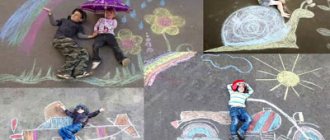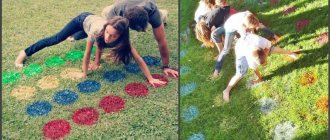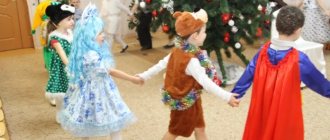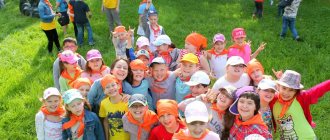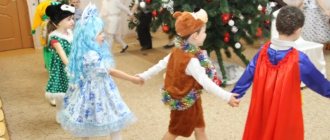Outdoor games have long been a well-known pastime for children. All folk traditional games can be divided into two groups: 1) winter games - games indoors, in a hut, 2) spring and summer games - games in the fresh air. All these games belong to the group of games with rules. And they are very important for the child’s health and for his preparation for school. After all, it is in playing with rules that a child learns to manage his behavior, to be guided by the rules in his activities, and this is the development of arbitrariness of behavior - the most important condition for success in school.
Many of these ancient outdoor games are now forgotten. I want to tell you a little about them. In this article you will find both outdoor games that can be played together and games for a large group of children - for a children's group or a parent-child group.
Outdoor games: ball games.
I know.
This outdoor game develops children's memory and attention. You can even play it together - a mother and one child.
Game option No. 1.
We hit the ball, bouncing it off the ground or off the asphalt. For each blow we pronounce a new name, repeating the previous one. For example:
I know one girl Alena.
I know two girls - Alena and Olya.
I know three girls - Alena, Olya and Vera.
I know four girls - Alena, Olya, Vera, Sveta...
The main thing is not to lose count and repeat the entire sequence correctly, without confusing the names in their order.
If a player goes down, he passes the ball to the next player. If you can never get lost, then he is a winner!
Similarly, you can call trees, cities, flowers, vegetables, fruits, minerals and any other names.
Game option No. 2.
This version of the game is much more difficult, as it requires switching attention. And you also need to not lose count and repeat the names in the chosen sequence.
Two parallel rows of names are lined up. For example.
I know one girl Alena. I know one boy, Petya.
I know two girls - Alena and Olya. I know two boys - Petya and Vova.
I know three girls - Alena, Olya and Vera. I know three boys -
Petya, Vova and Yura.
I know four girls - Alena, Olya, Vera and Masha. I know four boys - Petya, Vova, Yura and Seryozha and so on.
Such games are very useful for developing a child’s memory and attention, preparing him for school, and developing the ability to quickly switch and concentrate.
Big ball.
To play you will need a large ball that you can kick. All players face in a circle and join hands. The driver stands in the center of the circle and tries to roll the ball out of the circle with his feet. The players don't let him do it. If one of the players misses the ball, he becomes the driver. But the second round of the game goes differently. The players now stand facing out of the circle and join hands. The driver's task is to roll the ball back into the circle. If this is successful, then the player who missed the ball becomes the driver.
Again, the children stand facing in a circle and the game is repeated.
The rule of the game is that the ball cannot be picked up, you can only roll it with your feet.
This game can even be played by three people. Then a couple of players stand facing the driver and form a hoop. Their task is not to let the ball into the goal, that is, among themselves.
Ball up
- Everyone stands in a circle. The driver throws the ball up with the words: “Ball up!” (in some versions of this game, fictitious words are pronounced that do not exist in the Russian language; such a word - a signal - can be invented together with the children and shouted out in this game). At this time, all players run away from the driver as far as possible.
- The driver catches his ball and shouts at this time: “Stop.” All players who have run away must stop and freeze in place.
- The driver’s task is to throw the ball and hit or stain one of the players with it. If he managed to stain a player, then this player becomes the driver in the next game. If it was not possible to stain the player, then the same driver will have to drive again.
Rules of the game:
- The driver throws the ball up as high as possible.
- The driver catches the ball either from the air or from one bounce from the ground.
- If the player does not stop at the “Stop” signal, then he needs to take three large steps towards the driver.
- Players should not hide behind objects or trees.
Tag
Games of tag take place either in a spacious room or in the air, where children gather in any number, from 4-5 to 25 or more.
Having gathered, the children choose one from their midst and give him the nickname tag; His role is that he carefully watches the children running in different directions and tries at all costs to catch one and stain him, that is, touch him with his hand.
The one caught is delayed in this way and turns into a “tag,” while his name is pronounced loudly so that his comrades know who they should beware of.
As soon as he, in turn, catches one of the participants, he immediately transfers his role to him, moving himself into the group of children fleeing.
This game should be continued until the children maintain a keen interest in it and do not feel tired.
Tag games are primarily based on movement; they can, however, be varied by introducing various elements, for example throwing a ball and the like.
Outdoor games: play on the swing.
Game "Popinuh" with a patchwork ball.
Previously, on Easter days they made large swings that could accommodate many people, and not only children, but also adults swung on such swings.
Now in our yards the swings are designed for only one child. What to do if there are many people who want to swing on a swing and an eternal dispute arises: who is first? The traditional “give way to the little one” or “give way to the girl” is usually perceived with resentment: “Why should I give in again, because I also really want to swing, even though I’m a boy and only a year older.” Of course, you can choose the order according to a counting rhyme or lot, so that no one is offended.
But there is another way - very fun and interesting. This is a traditional Russian swing game “Popinukha” - a fun game so that no one stays too long on the swing and everyone can ride on it. In the past, both children and teenagers played this game. The game develops coordination of movements and dexterity, ingenuity, and the ability to observe. After all, to win, you need to predict the trajectory of the ball and throw it correctly to the leader. Here's how to play this game outdoors.
What do you need to play on a swing?
Previously, girls used to sew a special ball for this game - “popinhuha” with a diameter of up to 20 cm. The ball was stuffed with rags, tow, sawdust and decorated with ribbons and braid. Instead of a ball, they used a bunch of straw, a mitten, an old bast shoe or another object that was at hand.
Nowadays, the easiest way to make a kick ball is from an unnecessary sock or colored children's tights.
1.Cut off the “pipe”. Tighten the hole on one side with a strong thread.
2.Fill the resulting “bag” with padding polyester or rags (old unnecessary things, cut into small shreds). Women's nylon tights that have gone out of use are also suitable as padding - the ball will be elastic.
3.Next, tighten the second edge of our “pipe-bag” with thread. And decorate the tightening area with colored buttons or ribbon bows.
You can sew it differently: make a bag out of bright colored cotton fabric, fill it with rags and tie it. It will also turn out to be a kick. You can use an out-of-use mitten, stuffing it with rags and decorating it with buttons and bows. Look at what other items you have, they will all be suitable for becoming a booty in this game.
A sounding object was always placed in the middle of the popinukh ball. These days it could be a rustling flower package or a bell. You can fill a plastic Kinder Surprise box with peas. Or put small peas in walnut shells. In folk tradition, a birch bark tube with peas inside was placed inside the popinukha.
How to play "popinhuha"
Game option No. 1.
- One child is swinging on a swing (we choose him based on the counting rhyme). Other children stand facing the swing. The person swinging on the swing sings 1-2 verses of the song (this is agreed upon in advance).
- The players take turns throwing a kick ball to the person sitting on the swing (they throw the kick ball at the feet of the child swinging on the swing so that he can hit the ball, that is, kick it). To make the kick stronger, it is better to throw the ball when the swing is moving towards the thrower.
- After the kick, all players rush to catch the kick ball. The goal is to catch the ball before it hits the ground.
- If the player managed to catch the ball, then he sits on the swing instead of the previous child and swings on it. He begins to sing his 1-2 verses, then they throw a slap at him, he pushes it away from him, and so on as the game progresses.
- If the person swinging on the swing could not hit the ball from his knees or feet, he leaves the swing. Then the child who threw the ball sits on the swing.
- If the person swinging on the swing hits the ball, but the players do not catch it, then he remains swinging on the swing.
Game option No. 2.
- One child sits on the swing (we will choose him according to the counting rhyme). All other children who also want to ride on the swing stand near the swing facing the swinging child.
- A child swinging on a swing sings a song (they agree in advance how many verses he will sing). You can recite poetry, sing ditties, or count to 20 - any task will do. You will find several swing ditties for this game below.
- After listening to the end of the ditties (song, poem, counting, etc.), the players take turns throwing the pop-ball to the person sitting on the swing. If a child swinging on a swing was able to catch the ball, then he remains swinging. If not, then he gives way to the player who threw the kick.
Poems for swing games
Swing choruses - “profits” for playing on a swing
Swing ditties
Centipede
Playing with tied feet brings not only joy to children, but also a sense of cohesion. Therefore, you can safely offer them, for example, such a task.
Divide the guys into two teams and give each a rope about fifty centimeters long. With them, members of one team must tie their legs (at the ankles) with a comrade standing next to them. This way, you won’t end up with a bunch of scattered kids, but two centipedes (which is much easier to manage!).
Now have both centipedes stand at the starting line. Now they will compete in the dexterity of their legs! You can start with a simple task: have them try to reach the finish line as quickly as possible.
Then the task can be complicated.
For example, in the middle of their path, place a small obstacle that the children must take turns carefully overcoming, remembering their “neighbor.” Or you can change the trajectory of movement by placing limiters that you have to go around. If the children want to show aerobatics, you can even require them to pass the toy from the first to the last team member as they move.
Note. It is better not to get carried away with complicating the rules when playing this game with young children (up to six years old), since their motor regulation, as well as the ability for joint organized activity, is still far from perfect and they will fall more than they will move forward
Outdoor games: outdoor games with a group of children.
Zarya-zaryanica.
This is a round dance game. All children stand in a circle. And Zarya the Zaryanitsa stands behind the circle and holds a handkerchief in her hands. The round dance goes in one direction in a circle, and Zarya Zaryanitsa goes in the other direction around the round dance.
Children sing or say:
“Zarya-Zaryanitsa - to these words the round dance and Zaryanitsa move in a circle in different directions. The red maiden walked across the field, dropped the keys, golden keys, blue ribbons, entwined rings.”
Next, Zarya puts her handkerchief on the shoulder of the player in the round dance and says: “I went for water!” All players say in unison:
“One, two, three, Don’t be a crow!” And run like fire!”
At these words, Zaryanitsa and the child, who had a scarf placed on his shoulder, run in different directions around the round dance and run around a full circle. Whoever runs around the round dance faster and stands in it, taking a place, will play in the round dance. The one who did not have time becomes Zaryanitsa and the game continues.
Burners.
How to play burners:
Children stand in pairs, one after another, in a column. In front of this column, the driver stands facing the children - the “burner”.
The children chant the words:
“Burn, burn clearly, so that it doesn’t go out! Stand at your hem, Look at the field. There are trumpeters riding and eating rolls. Look at the sky: The stars are burning, The cranes are shouting: “Gu-gu, I’ll run away, One, two, Don’t be a crow, But run like fire!”
In response to these last words, the children from the last pair in the column unclasp their hands and run forward along the column to its beginning. Each player runs from his side. And the burner is trying to stain them.
If the players managed to run and stand as the first pair in the column, then the burner turns on again and “burns.” If the burner stains a player, then that player becomes a burner in the next game and the game is repeated.
Corners.
Children have been playing this game outdoors for many decades and centuries in different regions of Russia - Vyatka, Tobolsk, Astrakhan, Vladimir. It is also known that children played this game in Europe. For example, in France it existed under the name “Four Corners”, and the driver in France, instead of a mouse, was called “gap” or “pot”.
They used to play this game in the log house. Then - in my childhood - we also played this game, and we came up with it ourselves, but instead of a log house we used a square sandbox with sides in our yard. Instead of a log house or sandbox, you can simply draw a square with a side of about 2.5 meters on the ground or asphalt.
How to play corners?
You can play with 5 people or more. Four people stand in the corners, and the fifth player is the mouse. The mouse stands in the center of the square.
The mouse says: “From corner to corner!”
At these words, the children change places. You need to run across and take a place in another corner. The mouse also tries to occupy the vacant corner. Whoever is left without a corner becomes a mouse, stands in the middle of the sandbox or square and leads in a new game.
In another version of the game, it is not the mouse who speaks the words, but the players who speak to the mouse:
“Mouse, mouse, Sell the corner. For the awl, for the soap, for the white towel, for the mirror!”
and change places.
Confusion.
This wonderful and very interesting ancient folk game in the fresh air is often used in modern psychological training for children and adults. It is very useful for bringing people together, removing barriers, and bringing a joyful mood. This game can be played indoors, in a gazebo, on the veranda, at a birthday party, with guests, in the park or in the forest, in the country or in the yard. Moreover, everyone plays this game together - adults and children.
How to play confusion.
Mother and daughter are selected from the players. Mom leaves. All players join hands with each other in a circle. My daughter is confusing this round dance - you can crawl under your arm like a gate, step over your arms, turn around. The main condition is to do this without releasing your hands. When the players are completely confused with each other, they call their mother: “Mom, unravel the thread!” Just don’t tear it!”
Mom tries to unravel the confusion and return everyone in the circle to their place. The rule is the same - players should not release their hands when untangling.
If the mother has untangled the confusion, then a new mother and daughter are chosen. If not, then mom is playing another game.
If there are few participants in the game, then you can get entangled with a rope.
Horses
For the game, it is most convenient to use a large space in the yard or a spacious classroom. There can be any number of participants.
Children according to height are placed on one line, in one row, and are divided, starting from the outermost, into groups, which include four participants. One of the groups is called the indigenous people and retains the once captured place; to the left and right they are adjacent to two groups of fasteners. The latter groups include coachmen.
After everyone has settled down in this way, the coachmen take off their belts, thread them through the belts of the members of the root group, grabbing both ends of the belt with their right hand so that the belt buckle is between the index and thumb, and the opposite end of the belt is between the middle and index fingers. fingers; Thanks to this gripping of the belt with the fingers of the right hand, it is possible to quickly remove it at any time.
For greater order in the game, one of the older participants is elected “master of the threes.” At the signal given to them, the “troikas” begin to move forward, at first slowly moving forward, then gradually accelerating their steps, starting to run in one direction, then they gradually change this direction and scatter in all directions, according to the new order of the owner.
As soon as the “master of the troikas” shouts: “horses, in different directions!”, the coachmen immediately release the belts intertwined with the belts of the horsemen, and the freed horses quickly rush in different directions.
After some time, the owner again commands, “Coachmen, bridle the horses!” After this shout, the coachmen take each other by the hands, forming a chain, and begin to move from one end of the room or yard, which serves as a place for the game, to the opposite, driving the horses there as well. The main element of this game is walking and running, and if it takes place outdoors, then its benefits for children are obvious.
Bear
The number of players can be as large as desired, and the place for the game is also a spacious classroom or a large courtyard or area adjacent to the school.
Participants in the game choose by lot one comrade from among themselves, who is entrusted with the role of a bear, and supply each with tourniquets - the latter are not difficult to make by rolling up handkerchiefs accordingly.
On one side of the space allocated for the game, a small place is set up, or rather, limited by a line, which serves as a den for the bear. At this signal, the children rush from one end of the yard or classroom to the opposite, and the bear, not armed with a tourniquet, rushes at them, trying to touch one of them with its hand, i.e., to stain it.
The spotted one also becomes a bear and is taken to the den. The game continues in this order until there are more bears than the remaining participants in the game.
As the number of the bear's helpers increases, they all go out with him to hunt for prey and are placed in a row, with only those on the edges having the right to catch the players. The main element of the game is running.
Cat
Children gather in a spacious place. The best time to start this game is as soon as dusk begins to fall. Participants choose one from their midst who is distinguished by dexterity and agility, and entrust him with the role of a cat. The cat carefully hides behind a tree or bush, trying to remain unnoticed by its comrades.
The latter, at a signal from one of the elders, rush in all directions to look for the cat; the cat meows from time to time, making its presence known, and quickly hides so as not to be open.
The game continues until the cat is found, then another cat is again assigned by lot and the game is played until the children get tired or lose interest in it.
